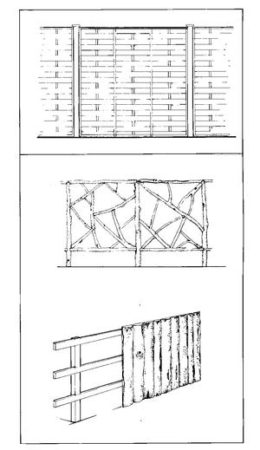Post category: Fences
Wooden fences can be supported by wooden or concrete posts. Wooden posts should be heavy enough to support the weight of the fence and the pressure of the wind. They should be long enough to allow about one quarter of their length to go into the ground.

Fences
Click here to view bigger sized image
Concrete posts are much stronger and last longer. They suit wooden panel fencing but not other fence types, trellis for example. Wooden support posts are best made of hard wood such as oak, although these can be difficult to get, or pressure-treated softwood. Soft wood posts simply painted with wood preservative will last only two or three years.
Posts must be put in the ground firmly, to hold the wooden fencing panels. Measure out accurately where the posts should go, marking each spot with pegs. Dig holes about 30 centimetres square and 50 to 70 centimetres deep.
Some big stones can be used to part fill the hole and help to retain the posts in position. Next, three-quarters fill the holes with concrete made of 4 parts gravel, 1 part sand and 1 part cement. Using a concrete footing is the most secure way to set up a fence and it is easier than driving the stakes, which is difficult to do accurately.
The stakes are stood in the holes as described in a straight line and at the correct spacing and are made exactly upright with a spirit level, using three or four temporary props of light timber nailed lightly to hold the post in position. The hole is filled to the surface and gently rammed in position. Check the props to make sure the stake is straight.
Allow the post foundations to set for a day or two and then nail the wooden panels into position, with constant checking that they are straight and in line, or use metal clips.

Fences
Click here to view bigger sized image
Rustic fencing can be tackled in the same way, except that forest poles are used instead of panels. The base of the poles in the ground should be treated, but the rest need not.
Specially made metal footings can be set into the concrete to get over the problem of wooden posts rotting just at ground level.
A wooden fence does not last as long as a wall but the useful life of a fence can be extended by painting it with wood preservative or paint. Supports for plants should be capable of being dismantled to allow painting. Most climbing plants are flexible enough to be leaned away from the fence during painting.


